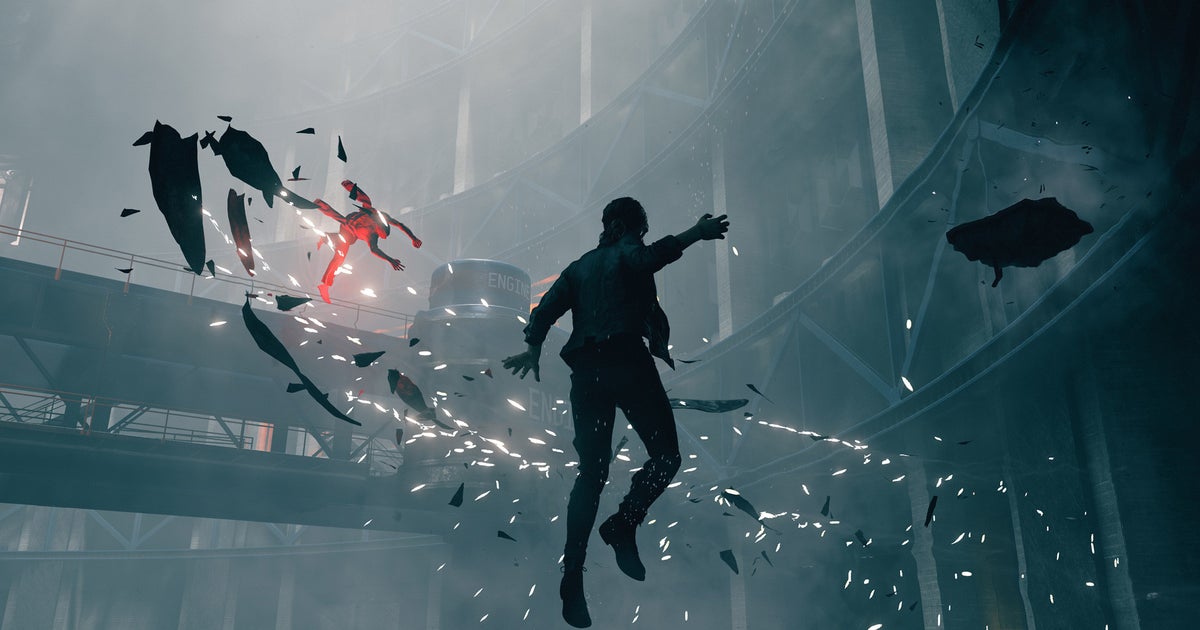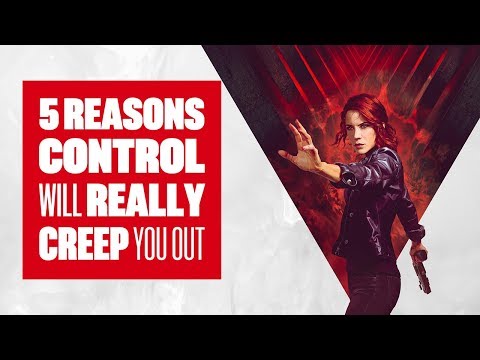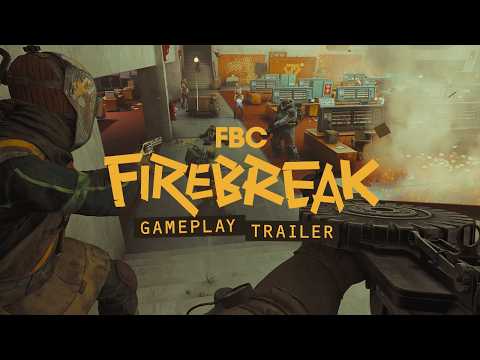Stop me if you’ve heard this before. We say “uncanny”, but in Germany it’s “unheimlich”. The unheimlich was a big deal for people like Freud, and it’s hard not to love the term, just a little bit. Unheimlich means, well, it means uncanny – weird, eerie, unsettling. But more specifically, it translates as “unhomely.” Unhomely. Now that is a word that carries a chill, a creep of the flesh, a word that registers an arachnid skittering in the corner of your vision. When something is familiar and unfamiliar all at once! You should feel like you’re at home, but…
Testify! Rotary telephones with no dials. Bodies suspended in the air with a kind of ballerina poise and elegance. Staff portraits, but they’re, like, full-blown oil paintings, dark eyes and unknowable aspects. When it comes to the uncanny, there’s one big budget game that really delivers on it for me. It’s Control. It’s a shooter, I guess, a third-person action game inspired by everything from The X-Files to House of Leaves to tropical Brutalism. There’s a splinter of Psi-Ops: The Mindgate Conspiracy and even Stranglehold in there too. But it’s also pure, delicious, slow-dripping uncanniness. It’s familiar and unfamiliar. It’s… Well…
Control is set within a building known as the Oldest House, and here, already, things are getting weird. Lots of games are perfectly house-sized. Edith Finch. Maniac Mansion. But a special few are set within houses that feel much bigger than the game they contain – much bigger than a single imagination could ever understand. Jet Set Willy. Impossible Mission. Control. The Oldest House contains Control, then, but it also feels like it contains so many other things, so many other implausible, improbable, impossible things. This week, for example, Remedy gave us a taste of FBC: Firebreak, a hectic multiplayer action game. Yes, it’s set in the world of Control, but more specifically it’s set within the Oldest House. Why not? There’s plenty of room.
In Control’s fiction, the Oldest House is the headquarters of the Federal Bureau of Control. This is a government agency that deals with extremely bizarre stuff. But the Bureau’s surfaces are beautiful and often quietly elegant. The face the Oldest House presents to the world is one of tastefully curated mid-century modernism. Wood looks like wood. Tile looks like tile. Concrete looks like concrete, and there’s lots of it, along with indoor bays for tropical plants and wide staircases and bright overhead lighting that’s perfect for giving ghostly shape to cigarette smoke.
Players come to the Oldest House as Jesse, a woman searching for her kidnapped brother. That’s a straightforward set up, and a game as unmoored as Control needs it, just as it needs the surprisingly strict confines of its third-person combat. Shoot stuff with a gun that can change form. Throw stuff around with your mind. Explore and clear out monsters as you dig for the truth. There’s this unexpected core of extreme orderliness at the center of Control, in terms of what you do most of the time and why you’ve been told you’re doing it. In retrospect, I guess the name of the game was a hint. This orderliness allows the designers to then bolt on all kinds of antic zaniness with no danger of the whole thing collapsing into fripperies, and it reminds me a little of the way that even the most extravagant skyscraper begins with the fixed core of its elevator shafts. (In Control, it’s the central elevator that often sends you off on missions. It all works!)
The plot is really just there to direct you back and forth through the Oldest House itself, though, and like all uncanny things, transformation is always in the air. Sometimes the Oldest House is doing the transforming. Sometimes you’re more directly in charge. Both these approaches are brilliant.
When it comes to the Oldest House’s own tricks, it tends to start with subtlety. Places will take slightly too long to reach. The signage looks weird and announces unusual departments. The technology is of the wrong era – green-screen computers? Bakelite phones? Radio equipment that looked like it may have been of use during the space race? This is all just the prelude, the aura before the migraine. But soon the Old House is revealing itself in full. Rooms telescope or twist, like the architect behind the place was willing to bust out a Spirograph. Smooth surfaces give way to jumbled blocks. In one area, chill infects the corridors and the glass freezes over, and are those tree trunks in the distance? In another, a furnace radiates the full heat of the sun.
This is where that splinter of internal order really helps. It helps to orient. Because you know what you’re doing and why you’re doing it, the building can transform around you in quite wild ways without becoming frustrating. But the Oldest House also has a lovely sense of pace. It will go wild for a few moments and completely transform itself, but then it turns quiet again. Safe? Ah, but now you’re left questioning the simplest things – the background hum, the volume of a room. Did I walk this way before? Was this hallway pointed in the same direction?
Further on things get really, really weird, but in a way the Oldest House is at its best before it drops too far into sci-fi. It’s at its best when it’s got something tricksy, something of the funfair to it. There’s an incredible sequence towards the end of the adventure when the Oldest House flings everything at you and you’re racing through an environment that warps and twists and strobes, an environment that truly contains multitudes. This is fantastic, and feels like the middle-eight in a song, changing things up and leaving them elevated. But it’s not the moment people mention the most in my experience when they talk about Control. That moment is an office that is simply overrun with Post-its. Post-its belong in offices, of course, but here they cover absolutely everything. Familiar and unfamiliar. And kind of funny, too.
And here’s a thing I really admire about Control. It’s willing to be very funny, but not in the way that games about hellish offices normally try to be funny. It doesn’t take the top-down approach, so often lifted wholesale from Portal’s precision wit and cruelty, in which humans are sane lab-rats in an insane hierarchy of faux camaraderie and corporate double-speak, a world in which there are a million euphemisms for dying at work and there’s a slice of cake promised if you can survive.
No. Control is funny because it looks at the way all offices affect the people who work within them – how the creeping of weird rules and weird ways of being is slow and measured and often hard to spot. The comedy here comes from how that quietly insane hierarchy in turn warps ordinary people. The fact that it relies on the supernatural, in a way, only makes it more relatable. It’s the comedy – and horror – of a room in which someone’s really busted out the Post-its. It’s the comedy of lamping someone with a photocopier.
And with that image, we’ve the other kind of transformation in Control. It’s the transformation brought about by the player, as they encounter the Oldest House’s many enemies and use gunfire and numerous supernatural abilities to fight back. The gun you’re given is pretty great, but Control’s really about telekinesis – about picking stuff up with your brain, watching it sway woozily in the air, and then lobbing it somewhere in order to really hurt something. It’s the transformation of impact, of violence and splatter. All that concrete is so eager to come apart in gritty chunks. All those office supplies are ready for a second life as a projectile or cudgel. You can take the Oldest House apart just as quickly as it tries to build itself into something monstrous. When I first played Control I would often end action sequences realising I was just firing wildly into the walls. They seemed, I guess, like a viable target.
And while Control’s mid-century vibes are very pleasant to engage with, it’s the violence – this is a very weird thing to say – that’s truly beautiful. When I first played the game, I remember chucking stuff at a filing cabinet for hours, just to enjoy the rippling of its drawers caused by the impact. In the moment of connection, it was briefly alive.
And after a particularly fraught battle I remember staring at a crater on the wall, made by the impact of some kind of white foam or powder – maybe the aftermath of a fire extinguisher? This crater, this moon landing on a wall, struck me as being one of the most beautiful things I’d ever seen in a game. Not least because I suspect if I’d played that encounter slightly differently, I would not have seen it.
There’s so much more to Control than this, but the uncanny takes strange shapes when it lives in the mind, and this is the shape Control has taken for me. It’s not the shape of the Oldest House, because who ever could map such a thing? But it’s a shape that clearly fits inside the Oldest House. Deep inside, where it works its strange, dark, endlessly charming magic.


